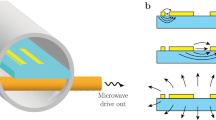Abstract
The remarkable advances of quantum computation technology with superconducting qubits based on circuit quantum electrodynamics (QED) architecture have been achieved by improving control, protection and measurement of the quantum states at the same time. At the heart of all these quantum operations, the significant enhancement of the qubit coherence time during the last decades was the key. Even after all these advances, the coherence and relaxation time of superconducting qubits still requires further improvements toward fault-tolerant quantum computation. Here, we report our observation of a strongly enhanced lifetime of an in-situ tunable superconducting transmon qubit on a silicon substrate that is embedded in a three-dimensional copper cavity. We measured a lifetime of the qubit of up to 84 µs, which is the best reported value of an in-situ tunable transmon on a silicon substrate. In our experiment, the in-situ frequency tunability over a broad range enabled the Purcell factor to be controlled continuously by detuning the qubit frequency against the resonator frequency in the strong dispersive regime. The silicon substrate has its own importance because the substrate should be fully compatible with the conventional semiconductor processes so that scalability and multi-chip module capability are guaranteed. In order to control the Purcell factor with another parameter, we displaced the qubit position in the cavity and observed a longer relaxation time with a smaller coupling coefficient. We believe that this systematic study and the control technique of the Purcell effect in the circuit QED design, together with minimizing the microwave photon loss through an improvement of the fabrication, will contribute to the realization of a practical large-scale quantum computer based on superconducting qubit technology.
Similar content being viewed by others
References
F. Arute et al., Nature 574, 505 (2019).
M. Kjaergaard et al., Annu. Rev. Condens. Matter Phys. 11, 369 (2020).
M. H. Devoret and R. J. Schoelkopf, Science 339, 1169 (2013).
P. Krantz et al., Appl. Phys. Rev. 6, 021318 (2019).
W. D. Oliver and P. B. Welander, MRS Bull. 38, 816 (2013).
Y. Nakamura, Y. A. Pashkin and J. S. Tsai, Nature 398, 786 (1999).
A. P. Place et al., ar**v preprint ar**v:.00024 (2020).
C. Rigetti et al., Phys. Rev. B 86, 100506 (2012).
A. Nersisyan et al., ar**v preprint ar**v:.08042 (2019).
A. Wallraff et al., Nature 431, 162 (2004).
J. Koch et al., Phys. Rev. A 76, 042319 (2007).
H. Paik et al., Phys. Rev. Lett. 107, 240501 (2011).
A. Dunsworth et al., Appl. Phys. Lett. 111, 022601 (2017).
B. Lienhard et al., ar**v preprint ar**v:.05425 (2019).
Y. Chu et al., Appl. Phys. Lett. 109, 112601 (2016).
J. M. Martinis et al., Phys. Rev. Lett. 95, 210503 (2005).
A. A. Houck et al., Phys. Rev. Lett. 101, 080502 (2008).
O. Dial et al., Supercond. Sci. Technol. 29, 044001 (2016).
J. A. Schreier et al., Phys. Rev. B 77, 180502 (2008).
J. Bylander et al., Nat. Phys. 7, 565 (2011).
M. D. Reed et al., Appl. Phys. Lett. 96, 203110 (2010).
E. Jeffrey et al., Phys. Rev. Lett. 112, 190504 (2014).
E. A. Sete, J. M. Martinis and A. N. Korotkov, Phys. Rev. A 92, 012325 (2015).
F. Yan et al., Nat. Commun. 7, 12964 (2016).
E. M. Purcell, H. C. Torrey and R. V. Pound, Phys. Rev. A 69, 37 (1946).
P. Goy, J. Raimond, M. Gross and S. Haroche, Phys. Rev. Lett. 50, 1903 (1983).
D. Kleppner, Phys. Rev. Lett. 47, 233 (1981).
A. Blais et al., Phys. Rev. A 69, 062320 (2004).
A. Wallraff et al., Phys. Rev. Lett. 95, 060501 (2005).
A. A. Houck et al., Nature 449, 328 (2007).
Acknowledgments
We greatly thank Dr. Sun Kyung Lee for data analysis and manuscript preparation. We thank **su Son and Junyoung Lee for their help in the simulation and the measurement. This work is supported by the R&D Convergence Program of NST (National Research Council of Science and Technology) (CAP-15-08-KRISS) and the Quantum Computing Technology Development Program of NRF (National Research Foundation) (2019M3E4A1079894).
Author information
Authors and Affiliations
Corresponding authors
Rights and permissions
About this article
Cite this article
Park, G., Choi, G., Choi, J. et al. Observation of a Strongly Enhanced Relaxation Time of an In-situ Tunable Transmon on a Silicon Substrate up to the Purcell Limit Approaching 100 μs. J. Korean Phys. Soc. 76, 1029–1034 (2020). https://doi.org/10.3938/jkps.76.1029
Received:
Revised:
Accepted:
Published:
Issue Date:
DOI: https://doi.org/10.3938/jkps.76.1029




